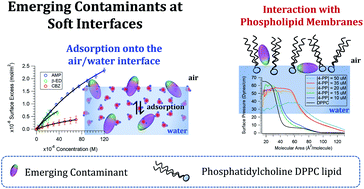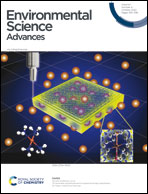Emerging environmental contaminants at the air/aqueous and biological soft interfaces†
Abstract
Detection of micropollutants, such as pharmaceuticals and industrial chemicals with endocrine disrupting potency, in ground and surface waters is of emerging concern. Within the aquatic environment, these emerging contaminants (ECs) can interact with various surfaces and biological membranes. The implication is that, provided the ECs exhibit sufficient affinity, these surfaces can modulate their fate and transport properties. Knowledge of the types of interactions with biomembranes can also help decipher their impact on aquatic organisms. Here, we show that selected organic micropollutants – amlodipine (AMP), carbamazepine (CBZ), β-estradiol (β-ED), and 4-propylphenol (4-PP) – exhibit proclivity for the air/aqueous interface. These compounds also interact differently with a zwitterionic phospholipid membrane. The adsorption free energy for the water surface, in the order of increasing affinity, is as follows: 4-PP < AMP < β-ED ∼ CBZ. Of the four compounds studied, 4-PP has the greatest extent of disruption of the phospholipid membrane. Our results suggest that the extent of interaction with the water surface and biological membrane is dependent upon the chemical nature of these micropollutants. This fundamental study highlights the importance of interfacial chemistry on the fate and transport of emerging contaminants in natural waters.

- This article is part of the themed collections: Topic Collection: Air Pollution & Air Quality and Urgent communications in RSC Environmental Science journals


 Please wait while we load your content...
Please wait while we load your content...